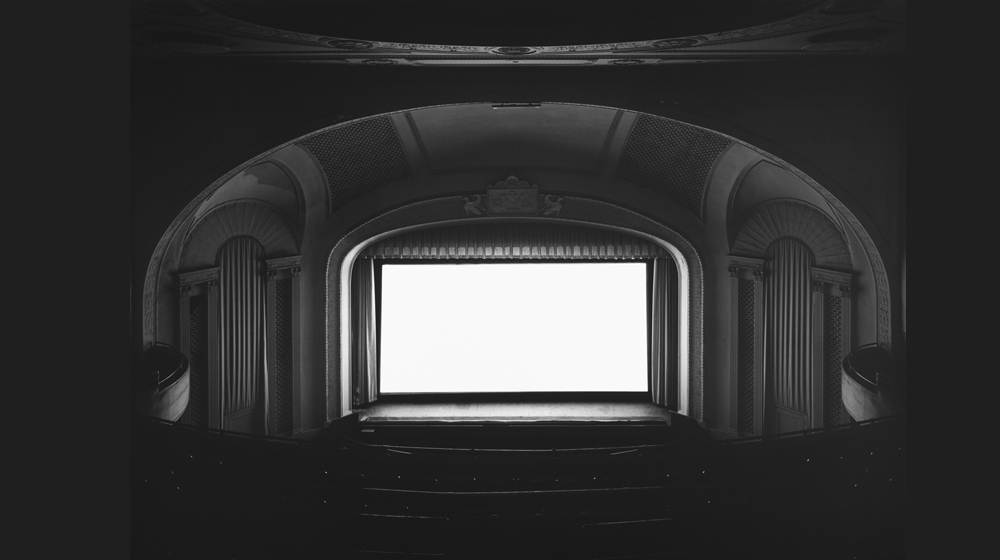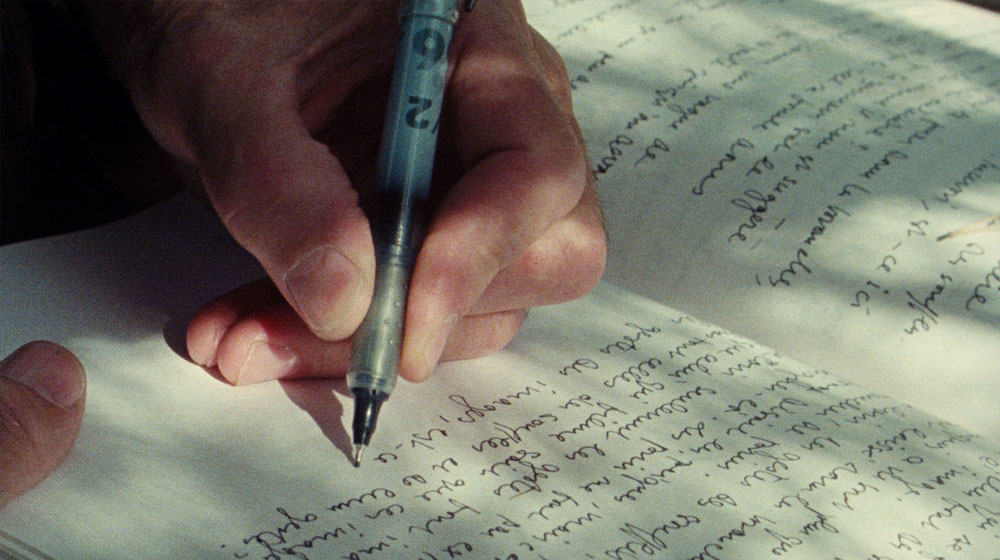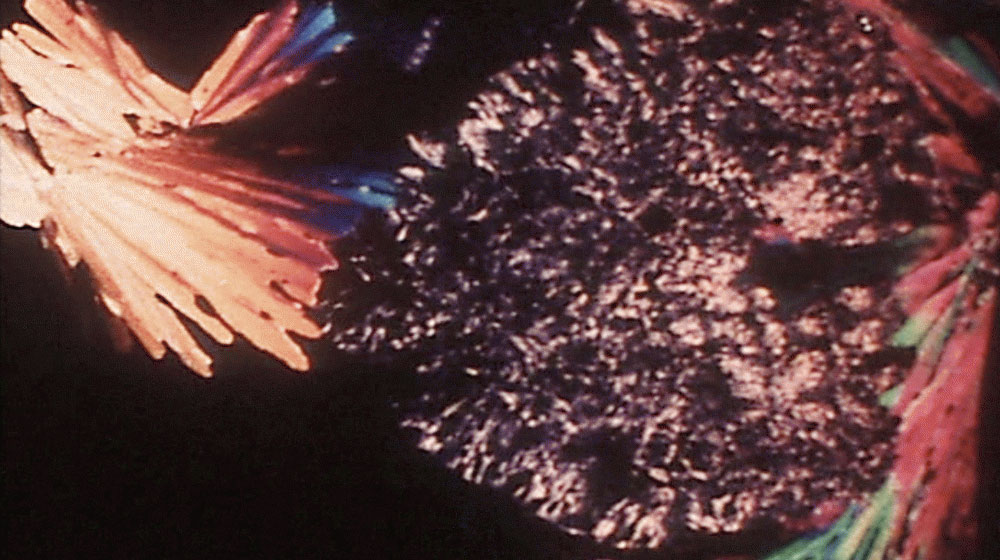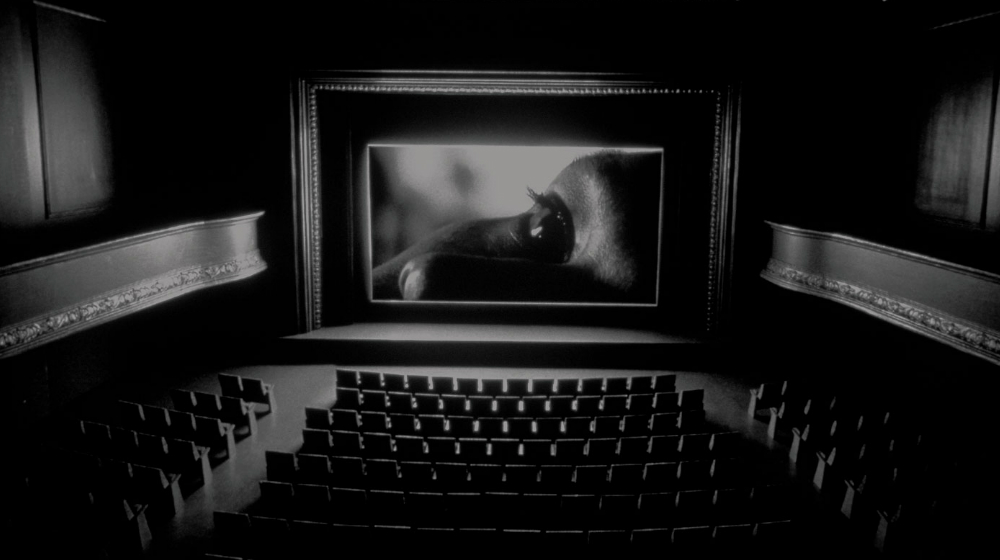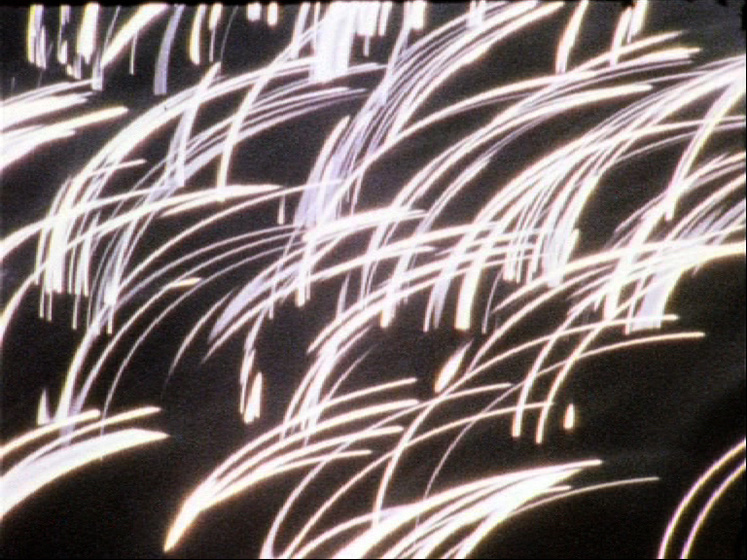“We learned long ago to see our rectangle, to hold all of it in focus simultaneously. [...] perhaps its sheer presence has as much to tell us as any particular thing we might find inside it.” Hollis Frampton (1)
Although today the boundaries of the screen are blurred and questions regarding it do not only affect the cinematographic sphere, when we think about this device we immediately link it with cinema and its conventional spaces for projection, mentally configuring images similar to those shown to us by the series of photographs Theaters by Hiroshi Sugimoto: a set of white screens shining out inside old cinemas. We imagine, precisely, the screen that was established over the years as the social space of projection: a flat and rectangular surface, installed in the centre of a dark auditorium in front of the viewer, while a beam of light, cast from behind him, registers the motion. In the darkness of cinema auditoriums, space is neutralised to give room to the projection while the screen, as it hides to adapt its fabric to the movement, retains no image, but includes all the images.
In his attempt to portray the space that cinema established for perception, the Japanese photographer took his camera into old cinemas in the United States, leaving the shutter open while the film was being shown. So the white screens included in this series of photos irradiate the light of all the images projected during each function. “So and so many watts of energy, spread over a few square yards of featureless white screen in the shape of a carefully standardised rectangle, three units high by four units wide. [...] The rectangle was here before we came and it will be here after we have gone. So it seems that a film is, first, a confined space at which [...] we, a great many people, are staring. it is only a rectangle of white light. But it is all films.” (2).
In addition to the images by Sugimoto, other works made use of the white screen to exhibit the cinematographic projection device, for example Zen For Film (1962-1964), the transparent film by Nam June Paik, the Yellow Movies (1972-1973) of Tony Conrad, a set of white paintings with proportions and rectangular frames similar to the cinema screen (3), and Screening Room (1968) by Morgan Fisher, a film that presents its projection space in a tautological way: a single shot taken in the same cinema where the film was screened, from the outside towards the flickering white screen (4). Together with the series of photos Theaters, these works present everything that stands behind a projection as support, the space that was designed to be invisible: the architecture of cinema auditoriums and the materiality of the screen itself.
However, the space prepared for the gaze by this screen would not be sufficient to explain the perceptive change that occurred at the start of the 19th century: a radical reconstruction of the vision that emerged linked to the new urban spaces just before the appearance of cinema. Architectures of glass and steel, night-time lighting, an increase in typographic information in the city and the speed of new modes of transport produced a perceptive disorientation and an intensive process of visual abstraction. Pre-cinematographic optical devices (the thaumatrope, the stereoscope and the praxinoscope, among others) seem to have prepared the observer for this transformation, subjecting his sensorial system to a complex training that adapted the eye to more rationalised forms of movement. Attention was thus disconnected from the perspectivist conception and from the atemporal and incorporeal order of the camera obscura, to be lodged in the physiology and temporality of the viewer’s body (5). The visual field of the new observer was complex and could not be expressed on the surface of a single screen, but it would rather be more like the diagrams produced by Herbert Bayer in the 1930s – Darstellung der Architektur. Fotoschau in Perspektive und Schnitt (1930) and Diagram Extended Field of Vision (1935) (6) – which presented the observer surrounded by a multiplicity of elements scattered in space, with a temporal and mobile perception that is, at the same time, multiple and selective.
Although cinema emerged within this context of a decisive alteration of the vision, over the years it adopted conservative forms of presentation and contemplation linked to previous systems of representation: theatre and painting. From theatre it received many of the mechanisms that the latter invented to manage the scenic space – the theatrical proscenium coincides with the cinematographic projection space, the scenes are gradually juxtaposed and the spectator accesses the events frontally, from the same place, the stalls – and from the pictorial space created in the Renaissance – the “imaginary” window of Alberti – the horizontal rectangular form of the screen. Thus constituting a space for contemplation inside the auditoriums in line with the old perceptive model of the camera obscura – a device which as it projected images on a flat surface separated the vision from the body of the spectator – leaving behind many forms that were tested in the years that preceded and followed early cinema.
The eidophusikon, a mechanical spectacle that emerged at the end of the eighteenth century and crossed a theatrical space with pictorial techniques in order to craft images in motion, configured a space for attention similar to that of cinema; however its representations had a materiality and a depth that was very different to the flat surface of cinematographic projection. This mini-theatre, produced by landscape painter Philippe-Jacques de Loutherbourg (1740-1812), was a kind of three-dimensional model that presented sequences of paintings on transparent fabrics, illuminated with different light filters, figures activated by strings and other ingenious mechanical devices. The spectator, positioned before it, contemplated representations of pre-designed natural phenomena – boats and waves in motion, a storm in the sea – while listening to different sound effects, a place of perception close to what cinema would constitute later. But to the contrary of what would be confirmed with the cinematographic screen, this show did not align its representations on a separate surface. Instead, each image was recorded on each fold of the device: visible volumes and textures, several layers arranged in depth that participated materially in the mechanical construction of the motion.
Although some pieces of pre-cinematographic optical apparatus had already presented their images on flat surfaces similar to the cinema screens, as in the case of the magic lantern (7), many others did not have a space for projection but rather the illusion of motion was produced on the viewer ’s retina. The image that was glimpsed as a thaumatrope turned – a disc with two different figures, one on each side– was an illusion caused by the persistence of vision: the eye’s capacity to always retain the last image. The stereoscope, by situating two images, one next to the other, with small variations, created in the observer’s brain an effect of depth and strange palpability. The phenakistoscope and the zootrope, working also on the eye’s hallucinatory possibilities, presented perception as an operation separate from the object and linked to the body of the observer, always integrating it as another component of its mechanisms.
In contrast with the numerous forms of presentation of images experienced in pre-cinema, the screen inside an auditorium established a place for projection that remained invariable for years: a horizontal rectangle always situated in front of an immobile viewer. The film industry barely introduced any changes into this space except during the 1950s, in response to the appearance of a new screen, television, when it incorporated a wider surface, with the insertion of two new filming and projection systems: cinerama (8) and cinemascope (9). This screen reconstructed, at conventional cinemas, a space of perception similar to that of the old panoramas (10) of the 19th century, on which they tested some previous films, designed to be projected simultaneously onto three screens, such as Napoléon (1927) by Abel Gance.
But the projection space that the industry standardised had not yet been established in the early years of cinema. The first device for viewing films, which was made by Thomas Edison, configured a space totally opposed to that of the collective exhibition that was established in cinema. The observer leaned on a wooden cabinet to watch, through an eyehole, images in motion enlarged through a lens. The kinetoscope was a kind of vision prosthesis that broke with the ‘scenic’ nature of the perception and linked it to the viewer ’s body. This individual mode of perception was, somehow, retaken by many screens that today fill everyday spaces: mobile phones, computers and other information surfaces that we find in shopping centres, on public transport, in stations and at airports, etc (11). Equally, early cinema, fascinated by the image in itself and by the medium’s different technical possibilities, constantly transformed the limits of its screen and created a visual experience that was very visceral for the spectator, full of blows and clashes (12). Managing a series of resources, such as caches and trick photography, the first projection surfaces were fragmented and acquired, temporarily, other geometrical shapes.
Some filmmakers even came to design other formats for screens beyond the standard representation. Sergei Eisenstein defended, in contrast with the passiveness of horizontal framings and their surfaces for projection, the active power of a vertical composition and screen, not to introduce a new format, but to invigorate the space for projection, integrating variable proportions into it (13). In those years László Moholy-Nagy had already proposed the abandoning of the rectangular screen in order to substitute it for a semi-spherical form, an idea that materialised in his project for multiple projections, the Polykino (1925). This form of presenting images, in addition to making up a circular surface for projection, which had a broad radius and a small depth, also simultaneously envisaged the displacement of the images produced by the movement of the projectors (14). José Val del Omar speculated, equally, in his film practices and in his writings on screen forms, with the aim of operating, as he called it, an “apanoramic overflowing of the image”, which would lead it to spread around the walls, ceiling and floor of the space (15).
In addition to these isolated attempts to tackle a projection surface that was starting to be hegemonic, a cinema emerged that has dematerialised it. In France, in the 1950s, cinema produced by the Lettrists (16) reconsidered projection mechanisms, making imaginary films, without a screen, nor images. “At the very moment that the screening should have started, Debord had to get up on the stage to say a few words of introduction. He simply had to say: there is no film to be screened” (17). In those years, other experimental film practices (18), investigating the different expressive possibilities of the medium, often based on the arsenal of techniques of early cinema and on pre-cinematographic perceptive mechanisms, transformed and over-ran the frame of the screen, making the difference between the projected image and perception quite evident. The first of the flicker films made, L’Anticoncept (1951) by Gil J. Wolman, Arnulf Rainer (1960) by Peter Kubelka and Flicker (1966) by Tony Conrad – films that work the monochromatic repetition of black and white – would illustrate this cinema’s place of projection well: the eye of the viewer. The intermittent images, constantly expanding and contracting, free themselves of the frame of the screen to occupy the space and infiltrate the body of the observer and may even cause epileptic seizures, as warned by Tony Conrad in the credits of his film.
These film practices, by questioning the device and integraing new spaces in the projection, prepared the ground for the expanded cinema of the 1960s, a set of actions that presented the screen as an element diffused into the everyday and removed from the traditional auditorium. In this context, multi-projection ambiences were also created, similar to those tried out in the 1920s by Abel Gance and László Moholy-Nagy, such as that designed by Stan VanDerBeek, the Movie-Drome (1965), a place where viewers immersed themselves in dozens of simultaneous projections. The notion of cinema was dilated to such a point that the “films” could, even, do without the screen and the film projection, as happened with Line Describing a Cone (1973) by Anthony Mccall, a work which reduced the film medium to its most minimal components: a white cone of light that crosses space, and with the actions of Valie Export in which she crossed cinema with performance practices. In one of them, Tapp- und Tastkino (1968), the artist transformed the skin of her body into a screen that could be palpated and touched, a box stuck to her chest, where passers-by could insert their hand.
Following the genealogy established by George Maciunas in his Expanded Arts Diagram (19), it appears the first sketchy attempts at expanded cinema took place not in the cinematographic sphere, but at universal exhibitions and fairs. It was at the Universal Exposition of Paris (1900) that one of the first multi-projection systems was presented, the Cinéorama, a device that had a circular 360 degrees screen and 10 projectors that linked techniques of panoramic painting with new cinematographic technology. In the Russian pavilion of the International Exhibition devoted to cinema and photography, Film und Foto (1929, Stuttgart), El Lissitzky took the principles of montage typical of cinema to the space, building three-dimensional structures that required an expanded vision by the viewer (20). Years later, this mosaic vision materialised in the multi-projection spaces designed by architects Ray and Charles Eames for the national american Exhibition in Moscow (1959) and for the World Fair of 1964 in New York, where films of theirs were exhibited such as Glimpses of USA (1959), a film on the American way of life shown in Moscow on seven suspended screens, and Think (1964), a projection for fourteen screens presented at the IBM ovoid theatre (21). In those years Czech scenographer Josef Svoboda had already exhibited at the Brussels Expo (1958) showing two different image presentation systems, the Laterna Magika, which fused theatre and cinema, and the Polyekran, a multi-projection technique that showed images on several screens with different forms: trapezoidal, square, etc., a device that he later radicalised at the Montreal Expo (1967) with a new method of three-dimensional multi-screens, called Polyvision, which presented images on cubes, prisms, spheres, etc.; projection techniques that overcame perspective and geometry and adopted an optical dynamic that disarmed the conventional cinematographic space.
Long before the introduction of the screen at museums, cinema had already been exhibited at universal exhibitions and fairs, places where expanded forms of the image were tried out along with new models of perception. It was only much later, at the end of the last century, that cinematographic projections were incorporated into these traditional artistic spaces, at a time in which their devices were already obsolete technology and other electronic screens were occupying everyday spaces (22). However, the incorporation of the screen at museums represented a historical adaptation to a new mode of perception and the projection of a virtuality that allowed, among other things, displacement of its spatial limits. However, as we saw, at that time the projection surface had disconnected itself from the movie theatres, from that frontal place prepared for the viewer, and had already created fractal spaces where the body became a machine for understanding.
The attempts that existed over the years to multiply, suppress or question the cinematographic screen only served to materialise the technical potentialities that were already present in the early years of cinema and express the complex visual field of the new observer. These film practices, by disconnecting the projection surface from conventional cinemas, returned it to the urban space, a place to which it appeared linked from its very beginnings. Expanding the sphere of action of its screen, cinema became a machine of perception diluted in the city and in its architecture, a device similar to that designed by Dan Graham in Cinema (1981): a model that implanted a cinema auditorium on the ground floor of a modern office building with a screen visible both inside and outside. If this cinema were built, the translucent walls would act as screens, mixing images in the film with those of the urban environment and establishing points of contact between spectators that are inside and outside the room. Inverting the habitual characteristics of projection devices, the film space would be integrated into the most immediate social network. Even if that cinema had been built, traditional cinemas would still exist, “this generic darkness, the only place left in our culture intended entirely for concentrated exercise of one, or at most two, of our senses.” (23)
Celeste Araújo
Image credits:
Hiroshi Sugimoto U.A. Playhouse, New York, 1978
Gelatin silver print
Image: 47 x 58 3/4 in. Frame: 60 11/16 x 71 3/4 in.
Courtesy of the artist and Marian Goodman Gallery
Notes:
- Hollis, Frampton, “A Lecture”, in On the Camera Arts and the Consecutive Matters. The Writings of Hollis Frampton, edited by Bruce Jenkins, MiT press, Massachusetts, 2009, p. 125-130.
- idem, p. 125.
- With this series of twenty “films” Tony Conrad aimed to frame the time that white house paint painted on sheets of paper would take to turn yellow.
- As explained in the credit titles, this Morgan Fisher film can only be screened at the Ahmanson auditorium of the Museum of Contemporary Art, Los angeles, as for it to be screened anywhere else a different version is required.
- See Crary, Jonathan, Las técnicas del observador, Visión y modernidad en el siglo XIX, CENDAC, Murcia 2008.
- Illustration published in a catalogue for an exhibition devoted to innovation in exhibition installation techniques, “Fundamentals of Exhibition Design” (1937), reproduced in Public Photographic Spaces, Exhibitions of Propaganda, from Pressa to The Family of Man, 1928-1955, edited by Anna Jiménez Jorquera, MACBA, Barcelona 2009, pp. 211- 219.
- A model of lantern existed at the end of the 19th century, the Malden Bi-Unial Lantern, which since it was equipped with two optical systems, allowed the multiple and simultaneous projection of two separate images, one on top of the other, vertically aligned, different from the unique presentation that was adopted by convention at cinemas. See Chadwick, W. J., The Magic Lantern Manual, Frederick Warne, London 1878.
- The cinerama is a wide-screen system that presents a panoramic image that is the result of the sum of those projected simultaneously by three projectors onto a curved surface.
- The CinemaScope was a filming and projection system that used anamorphic lenses to achieve a broader lens.
- The panoramas were gigantic paintings that were shown on a cylindrical surface, allowing a circular vision of 360 degrees which, lit up in a certain way, manipulated the perspective. These representations of landscapes and views of cities were generalised as spaces for the exhibition of images throughout the 19th century.
- See Friedberg, Anne, The Virtual Window, From Alberti to Microsoft, The MiT Press, Cambridge, Ma 2006, pp. 86-87.
- See Gunning, Tom, “The Cinema of Attraction: Early Film, its Spectator, and the Avant-Garde”, in Film and Theory: An Anthology, edited by Robert Stam and Toby Miller, Blackwell, Malden, Ma 2000, pp. 229-235
- See Eisenstein, S. M., “The Dynamic Square”, Close Up 8, no. 1 , 1931 , pp. 4-5.
- See Haas, Patrick de, “Entre projectile et projet. Aspects de la projection dans les annés vingt”, in Projections, les transports de l’image edited by Dominique Païni, Ediciones Hazan/Le Fresnoy/AFAA, Paris 1997, pp. 105-106.
- See Val del Omar, José, “Desbordamiento apanorámico de la imagen”, in Escritos de la técnica poética y mística, Ediciones La Central, Barcelona 2010, pp. 135-140. In a diagram on the “apanoramic overflow of the image” (handwritten document, ca. 1957) reproduced in this book, Val del Omar sketches different possibilities of overflowing the image of the “normal screen”, based on spatial tensions, with the horizontal panoramic expansion, and its time tensions with the vertical presentation and the double concentric projection.
- Lettrism, a French artistic movement, founded in 1945 by romanian poet Isidore Isou, is not strictly cinematographical but also encompasses literature and the plastic, performing and sound arts. Taking as a starting point the letter (not the word) as a graphic and sonorous sign, Isou founded a new conception of art that sought to overcome material limits. This applied to cinema, together with Maurice Lemaître, Guy Debord and Gil J. Wolman, meant questioning the conventional screen and its projection spaces.
- Isou, Isidore, “Esthétique du cinema”, Ion, no.1, 1952, p. 148.
- With this designation the aim is to make reference to independent American cinema and its diverse currents, as well as other film practices outside of this field, habitually designated as experimental cinema.
- Maciunas, George, “Expanded arts Diagram”, published in Film Culture, Expanded Arts, no. 43, 1966.
- “Enlargements of stills from films by Vertov and Eisenstein were mounted on transparent lath constructions of varying colours and hovered freely, and the walls were covered with orthogonal arrangements of film sequences and individual takes, presumably reportage photographs. The presence of several daylight film projectors indicate that extracts from the latest Soviet films were shown.” Ulrich Pohlmann, “El Lissitzky’s Exhibition Designs. The influence of His Work in Germany, Italy and the United States”, in Public Photographic Spaces, Exhibitions of Propaganda, from Pressa to The Family of Man, 1928-1955, edited by Anna Jiménez Jorquera, Barcelona, MACBA, p. 175.
- See Colomina, Beatriz “Enclosed by images: The Eameses’ Multiscreen architecture”, in Art of Projection, edited by Stan Douglas and Christopher Eamon, Hatje Cantz Verlag, Ostfildern 2009, pp. 36-56.
- “Industry exhibitions as the hidden constructive layout of museums; art: industrial products projected in the past.” Benjamin, Walter, Libro de los Pasajes, akal, Madrid, 2004, p. 197.
- Frampton, Hollis, op cit., p. 125.
